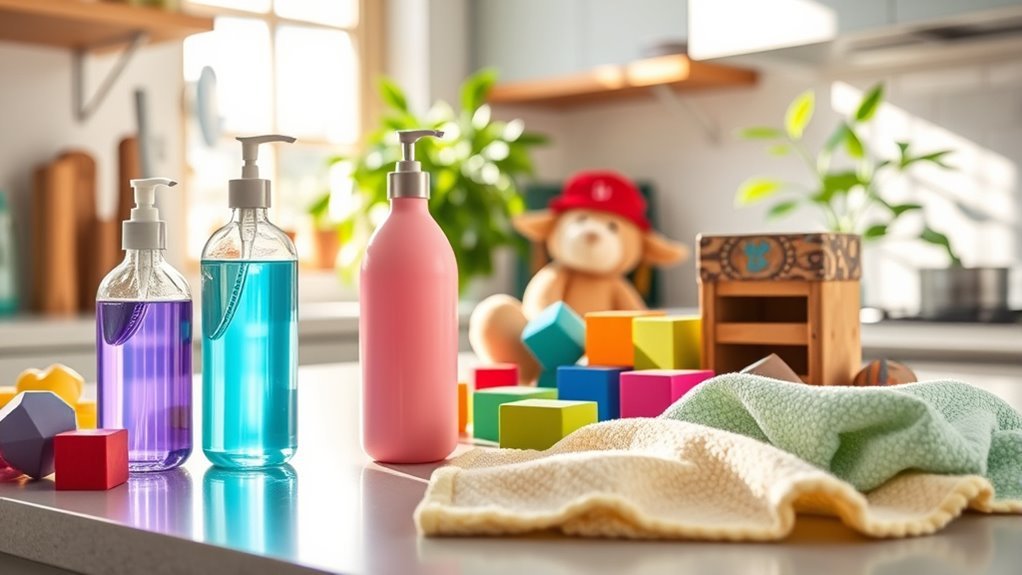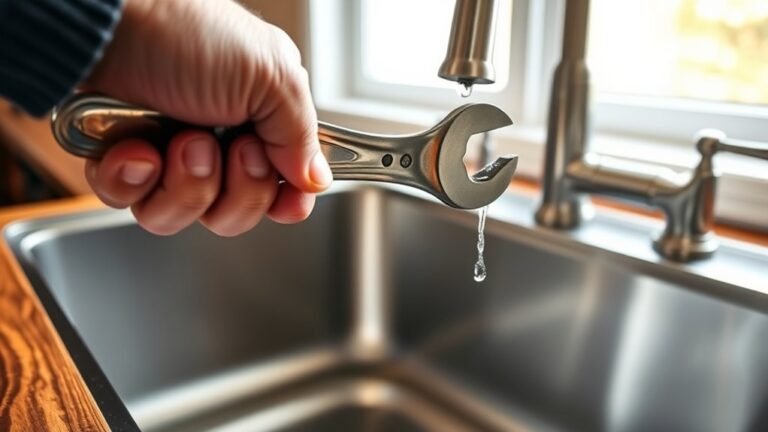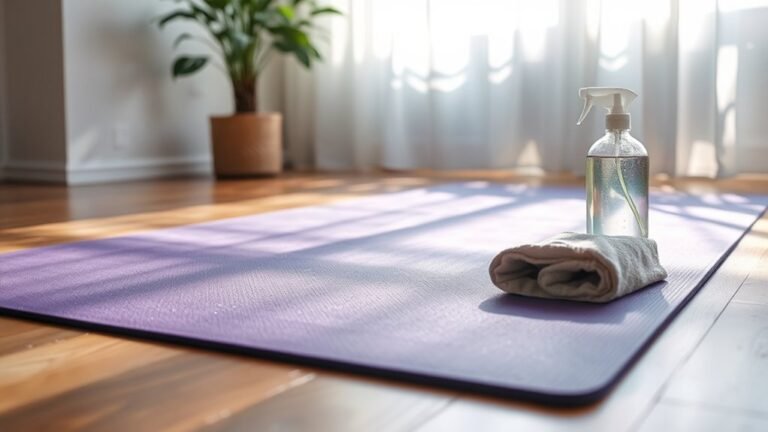Best Products to Clean Your Toys
You’ll want gentle fabric cleaners for plush toys to keep them soft, and mild dish soap works best on plastic toys without causing damage. For a natural approach, try vinegar solutions that disinfect safely. Baking soda’s great for removing odors. Disinfecting wipes and toy-safe sanitizing sprays offer quick cleaning, while microfiber cloths handle delicate surfaces gently. Electronic toys require specialized cleaners to protect sensitive parts. Keep going to find out how to choose the perfect product for every toy type.
Gentle Fabric Cleaners for Plush Toys

Although plush toys can get dirty quickly, you don’t have to worry about harsh chemicals damaging their soft fabric. When it comes to plush toy maintenance, choosing gentle fabric cleaners is key to preserving that cozy feel. You want products that clean effectively without stripping softness or causing discoloration. Look for mild detergents or specially formulated fabric care solutions designed for delicate materials. These cleaners allow you the freedom to refresh your toys safely, keeping them fresh and inviting. Avoid abrasive scrubbing or bleach-based cleaners that can harm fibers. With the right approach, you’ll maintain your plush toys’ softness and color, ensuring they stay as cuddly and comforting as the day you got them. Gentle fabric care is your best bet for long-lasting plush toy upkeep.
Mild Dish Soap for Plastic Toys
When you need to clean plastic toys, mild dish soap is a reliable and safe choice. It gently removes dirt and grime without harsh chemicals that could compromise toy safety. You can easily mix a few drops of mild, scented soap with warm water to create a cleaning solution that’s both effective and pleasant to use. Avoid strong fragrances or antibacterial soaps, as they may irritate sensitive skin or damage the toy’s surface over time. Using mild dish soap lets you maintain your child’s freedom to play safely while keeping toys fresh and clean. Just rinse thoroughly and air dry to guarantee no soap residue remains. This simple method respects both your desire for natural cleaning and your commitment to toy safety.
Vinegar Solutions for Natural Cleaning

You can use vinegar as a natural disinfectant to clean your child’s toys safely. Mixing one part vinegar with one part water creates an effective cleaning solution that’s gentle yet powerful. Plus, using natural ingredients like vinegar helps you avoid harsh chemicals while keeping toys fresh and germ-free.
Vinegar as Disinfectant
Since vinegar is both natural and affordable, it’s a popular choice for cleaning toys without harsh chemicals. You’ll appreciate the vinegar benefits like its ability to kill many germs while being safe for most surfaces. Vinegar safety means you avoid toxic residues, making it perfect for kids’ playthings. Just keep in mind, vinegar works best as a disinfectant on hard, non-porous toys.
| Vinegar Benefits | Vinegar Safety | Ideal Uses |
|---|---|---|
| Natural antimicrobial | Non-toxic, eco-friendly | Plastic toys |
| Removes odors | Safe around children | Metal toy parts |
| Affordable and easy | No harsh chemicals | Non-porous surfaces |
With vinegar, you get a free-spirited way to keep toys clean and germ-free without sacrificing safety.
Mixing Ratios for Cleaning
Although vinegar is effective on its own, mixing it with water at the right ratio guarantees safe and efficient cleaning for your kids’ toys. You’ll want to follow simple cleaning ratios—typically one part vinegar to four parts water—to create a gentle yet powerful solution. These dilution methods prevent any harshness that could damage toy surfaces or bother sensitive skin. By mastering these ratios, you control how natural your cleaning routine stays while ensuring thorough disinfecting. Just pour your mixture into a spray bottle or bowl, and you’re set to wipe down toys without worry. This balance lets you keep your children’s playthings safe and spotless, all while embracing a natural, freedom-friendly approach to cleaning.
Benefits of Natural Ingredients
When it comes to keeping your children’s toys clean, natural ingredients like vinegar offer a safer alternative to harsh chemicals. You’ll appreciate that vinegar solutions are not only effective but also eco friendly options that reduce your household’s chemical footprint. Using vinegar helps you maintain a toxin-free environment, which is especially important if your little ones have sensitivities or allergies. These allergy free alternatives minimize the risk of skin irritations and respiratory issues. Plus, vinegar’s antimicrobial properties make it a powerful cleaner against germs and bacteria without relying on synthetic ingredients. Choosing natural solutions gives you the freedom to clean confidently, knowing you’re protecting both your family’s health and the planet. It’s a smart, simple way to keep toys fresh and safe every day.
Disinfecting Wipes Safe for Toys

When choosing disinfecting wipes for toys, you’ll want options with non-toxic ingredients that won’t harm little hands. These wipes should effectively eliminate germs without leaving harmful residues behind. Let’s explore which products strike the perfect balance between safety and cleanliness.
Non-toxic Ingredients
Since toys often end up in little hands and mouths, choosing disinfecting wipes with non-toxic ingredients is essential to keep your child safe while effectively cleaning. You want wipes that use eco friendly alternatives to harsh chemicals, ensuring you’re not exposing your family to unnecessary toxins. Safe cleaning methods mean looking for wipes free from ammonia, bleach, and synthetic fragrances. Instead, opt for products with plant-based ingredients or natural antimicrobial agents that still do the job without compromising health. This way, you maintain a clean environment without sacrificing your child’s well-being or your own peace of mind. Choosing non-toxic wipes aligns with your desire for freedom—freedom from harmful substances, and freedom to let your kids explore safely. Always check labels and pick wipes designed specifically for toys and sensitive skin.
Effective Germ Elimination
Choosing wipes with non-toxic ingredients is a great start, but you also want products that effectively eliminate germs to keep your child’s toys truly clean. Focus on disinfecting wipes designed specifically for toys—they target germ hotspots like handles, buttons, and crevices where bacteria tend to hide. You don’t have to overdo it, but maintaining a regular cleaning frequency is key to preventing buildup and keeping germs at bay. Wipes that kill 99.9% of germs without harsh chemicals give you the freedom to clean confidently without worrying about residue or toxicity. By choosing the right wipes and sticking to a consistent routine, you empower yourself to protect your child’s health while preserving their playtime fun.
Baking Soda for Odor Removal
Although toys can bring endless joy, they often develop unpleasant odors over time. Baking soda uses extend beyond the kitchen—it’s a powerhouse for odor absorption in your toys. By sprinkling baking soda on the surface, letting it sit, then brushing or vacuuming it off, you’ll free your toys from stubborn smells without harsh chemicals. This method keeps your cleaning routine simple and safe, giving you the freedom to enjoy fresh-smelling toys anytime.
| Toy Type | Application Method | Odor Removal Effectiveness |
|---|---|---|
| Plush Toys | Sprinkle, wait 30 mins, brush | High |
| Plastic Toys | Sprinkle, wipe with damp cloth | Moderate |
| Wooden Toys | Light sprinkle, air dry | Moderate |
| Electronic Toys | Use cautiously, spot clean | Low |
| Mixed Materials | Combine methods as needed | High |
Toy-Safe Sanitizing Sprays
Toy-safe sanitizing sprays offer a quick and effective way to keep your child’s playthings germ-free without harmful chemicals. When choosing a spray, look for eco friendly options that protect both your family and the environment. These sprays usually use natural ingredients, ensuring you’re not exposing your little ones to toxins. Always consider the toy material before spraying; porous or electronic toys may require a gentler formula or less moisture to avoid damage. You can easily refresh plastic, rubber, and fabric toys, making sanitizing hassle-free. Using these sprays gives you the freedom to clean on the go, keeping playtime safe and worry-free. Just spray, wait a few minutes, and wipe if needed — your toys are ready for endless fun!
Microfiber Cloths for Delicate Surfaces
A microfiber cloth is a must-have for cleaning toys with delicate surfaces like screens, painted details, or soft fabrics. You’ll love the microfiber benefits—it traps dust and dirt gently without scratching or leaving lint behind. Using the right cleaning techniques, like wiping in one direction and avoiding harsh chemicals, keeps your toys looking fresh and vibrant. Plus, microfiber cloths are reusable and eco-friendly, giving you freedom from wasteful disposable wipes.
| Surface Type | Recommended Technique | Microfiber Benefit |
|---|---|---|
| Screens | Light, circular wipes | Non-abrasive, lint-free |
| Painted Details | Gentle, one-direction | Prevents paint damage |
| Soft Fabrics | Dabbing, not rubbing | Absorbs moisture effectively |
With microfiber, cleaning delicate toys is simple and safe.
Specialized Cleaners for Electronic Toys
When you’re cleaning electronic toys, you’ll want to use specialized cleaners designed to protect sensitive components like buttons, screens, and circuit boards. These products help maintain your toy’s performance while guaranteeing battery safety and overall electronic maintenance. Here are three must-haves:
- Isopropyl alcohol wipes – Great for disinfecting without damaging circuits.
- Compressed air cans – Perfect for blowing dust out of crevices without moisture.
- Electronic-safe cleaning sprays – Formulated to clean without leaving residue or harm.
Using these guarantees you keep your toys in top shape, free from grime, and safe from moisture-related damage. Remember to remove batteries before cleaning to avoid corrosion and preserve battery safety. Taking these simple steps means your electronic toys stay reliable, letting you enjoy freedom and fun without interruption.
Häufig gestellte Fragen
How Often Should I Clean My Children’s Toys?
You should think about cleaning frequency based on how often your kids play and if toys get visibly dirty. For toy hygiene, a good rule is to clean them weekly, especially for items your children put in their mouths or share with others. If your kids are sick, increase cleaning frequency to stop germs. Staying consistent keeps toys safe, letting your children enjoy their freedom to play without worries about germs.
Can I Use Bleach to Sanitize My Toys?
You might think bleach’s a quick fix for sanitizing toys, but it can be harsh and damage some toy materials like fabric or soft plastics. Luckily, there are bleach alternatives—like vinegar solutions or hydrogen peroxide—that are gentler yet effective. These keep your toys safe without harsh chemicals, giving you freedom to clean worry-free. So, skip bleach and choose safer options that protect both your kids and their favorite playthings.
What Is the Safest Way to Clean Wooden Toys?
When cleaning wooden toys, you’ll want to stick to natural cleaning methods to keep things safe and simple. Use a damp cloth with mild soap and water, avoiding harsh chemicals that can damage the wood or leave residues. After wiping, dry them thoroughly to prevent moisture damage. Regular toy maintenance like this helps preserve their charm and durability, letting you enjoy those timeless pieces freely without worrying about harmful substances.
Are UV Sterilizers Effective for Toy Cleaning?
Just like a knight’s shield guards against unseen foes, UV sterilizers protect your toys from harmful germs with impressive UV effectiveness. You’ll appreciate how they offer a chemical-free way to keep toy safety intact, especially for delicate materials. While they don’t remove dirt, UV light zaps bacteria and viruses, giving you freedom from worry. So, if you want a modern, safe method, UV sterilizers are definitely worth considering.
How Do I Dry Toys After Cleaning to Prevent Mold?
After cleaning your toys, you’ll want to use effective drying techniques to prevent mold. Start by shaking off excess water and patting them dry with a clean towel. Then, let them air dry completely in a well-ventilated area, ideally under natural sunlight or near a fan to speed up drying. Avoid storing toys while damp because trapped moisture encourages mold growth. Taking these steps helps keep your toys fresh and safe for your freedom to play anytime.






